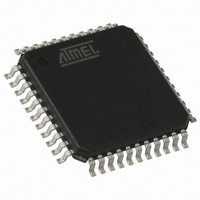AT89C51CC01UA-RLTUM Atmel, AT89C51CC01UA-RLTUM Datasheet - Page 20

AT89C51CC01UA-RLTUM
Manufacturer Part Number
AT89C51CC01UA-RLTUM
Description
IC 8051 MCU FLASH 32K 44-VQFP
Manufacturer
Atmel
Series
AT89C CANr
Datasheet
1.T89C51CC01CA-7CTIM.pdf
(167 pages)
Specifications of AT89C51CC01UA-RLTUM
Core Processor
8051
Core Size
8-Bit
Speed
40MHz
Connectivity
CAN, UART/USART
Peripherals
POR, PWM, WDT
Number Of I /o
34
Program Memory Size
32KB (32K x 8)
Program Memory Type
FLASH
Eeprom Size
2K x 8
Ram Size
1.25K x 8
Voltage - Supply (vcc/vdd)
3 V ~ 5.5 V
Data Converters
A/D 8x10b
Oscillator Type
External
Operating Temperature
-40°C ~ 85°C
Package / Case
44-TQFP, 44-VQFP
Processor Series
AT89x
Core
8051
Data Bus Width
8 bit
Data Ram Size
1280 B
Interface Type
UART
Maximum Clock Frequency
40 MHz
Number Of Programmable I/os
34
Number Of Timers
2
Operating Supply Voltage
3 V to 5.5 V
Maximum Operating Temperature
+ 85 C
Mounting Style
SMD/SMT
3rd Party Development Tools
PK51, CA51, A51, ULINK2
Development Tools By Supplier
CANADAPT28
Minimum Operating Temperature
- 40 C
On-chip Adc
10 bit, 8 Channel
Package
44VQFP
Device Core
8051
Family Name
AT89
Maximum Speed
40 MHz
Cpu Family
AT89
Device Core Size
8b
Frequency (max)
40MHz
Total Internal Ram Size
1.25KB
# I/os (max)
34
Number Of Timers - General Purpose
3
Operating Supply Voltage (typ)
3.3/5V
Operating Supply Voltage (max)
5.5V
Operating Supply Voltage (min)
3V
Instruction Set Architecture
CISC
Operating Temp Range
-40C to 85C
Operating Temperature Classification
Industrial
Mounting
Surface Mount
Pin Count
44
Package Type
VQFP
For Use With
AT89OCD-01 - USB EMULATOR FOR AT8XC51 MCU
Lead Free Status / RoHS Status
Lead free / RoHS Compliant
Other names
AT89C51CC01UARLTUM
Available stocks
Company
Part Number
Manufacturer
Quantity
Price
Company:
Part Number:
AT89C51CC01UA-RLTUM
Manufacturer:
ATMEL
Quantity:
3 200
Company:
Part Number:
AT89C51CC01UA-RLTUM
Manufacturer:
ATMEL
Quantity:
5 000
Part Number:
AT89C51CC01UA-RLTUM
Manufacturer:
ATMEL/爱特梅尔
Quantity:
20 000
Power-down Mode
Entering Power-down Mode
Exiting Power-down Mode
20
A/T89C51CC01
2. Generate a reset.
Note:
The Power-down mode places the T89C51CC01 in a very low power state. Power-down
mode stops the oscillator and freezes all clocks at known states. The CPU status prior to
entering Power-down mode is preserved, i.e., the program counter, program status
word register retain their data for the duration of Power-down mode. In addition, the
SFRs and RAM contents are preserved. The status of the Port pins during Power-down
mode is detailed in Table 14.
To enter Power-down mode, set PD bit in PCON register. The T89C51CC01 enters the
Power-down mode upon execution of the instruction that sets PD bit. The instruction
that sets PD bit is the last instruction executed.
If VDD was reduced during the Power-down mode, do not exit Power-down mode until
VDD is restored to the normal operating level.
There are two ways to exit the Power-down mode:
1. Generate an enabled external interrupt.
Note:
–
–
of the interrupt service routine, program execution resumes with the
instruction immediately following the instruction that activated Idle mode.
The general-purpose flags (GF1 and GF0 in PCON register) may be used to
indicate whether an interrupt occurred during normal operation or during Idle
mode. When Idle mode is exited by an interrupt, the interrupt service routine
may examine GF1 and GF0.
A logic high on the RST pin clears IDL bit in PCON register directly and
asynchronously. This restores the clock to the CPU. Program execution
momentarily resumes with the instruction immediately following the
instruction that activated the Idle mode and may continue for a number of
clock cycles before the internal reset algorithm takes control. Reset
initializes the T89C51CC01 and vectors the CPU to address C:0000h.
1. During the time that execution resumes, the internal RAM cannot be accessed; how-
2. If Idle mode is invoked by ADC Idle, the ADC conversion completion will exit Idle.
The T89C51CC01 provides capability to exit from Power-down using INT0#,
INT1#.
Hardware clears PD bit in PCON register which starts the oscillator and
restores the clocks to the CPU and peripherals. Using INTx# input,
execution resumes when the input is released (see Figure 9) while using
KINx input, execution resumes after counting 1024 clock ensuring the
oscillator is restarted properly (see Figure 8). Execution resumes with the
interrupt service routine. Upon completion of the interrupt service routine,
program execution resumes with the instruction immediately following the
instruction that activated Power-down mode.
1. The external interrupt used to exit Power-down mode must be configured as level
2. Exit from power-down by external interrupt does not affect the SFRs nor the internal
ever, it is possible for the Port pins to be accessed. To avoid unexpected outputs at
the Port pins, the instruction immediately following the instruction that activated Idle
mode should not write to a Port pin or to the external RAM.
sensitive (INT0# and INT1#) and must be assigned the highest priority. In addition,
the duration of the interrupt must be long enough to allow the oscillator to stabilize.
The execution will only resume when the interrupt is deasserted.
RAM content.
4129N–CAN–03/08













